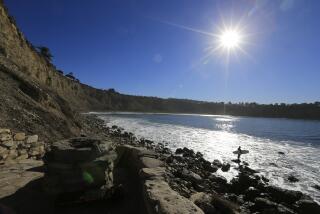He’s Found His Endless Summer
- Share via
TAMARINDO, Costa Rica — When visitors measure the inconveniences of settling down in this northern beach resort, invariably their list includes insects, humidity, long delays for housing materials, wild drivers, squatters and politics.
And that’s a short list.
But none of that seems to matter when a small group of friends assembles at Robert August’s home.
As they huddle on the balcony, one of August’s surfing comrades looks around, notes the mountains of Guanacaste Province in twilight, and declares: “Robert, we’ve achieved sunset.”
Glasses clink, beers are hoisted in what has become a daily ritual here at Casa Augosto, when August, 51, and guests pause in consideration of nature, as if in the land of rain forests, scarlet macaws and monkeys there should be such formalities.
For August, who starred in filmmaker Bruce Brown’s surf classic, “The Endless Summer,” the day’s finale was a fitting salute to a five-year struggle to build a retirement home in Tamarindo.
The Huntington Beach surfboard manufacturer is not the only one from Orange County who has found happiness among the ticos, as Costa Ricans prefer to be called. Surfer’s Journal publisher Steve Pezman of San Clemente and Donald P. Hayes, also of San Clemente, also have taken the Costa Rican plunge, as have dozens of retirees.
August’s neighbors include Joey Vogan, a 34-year-old electrician from Huntington Beach who wants to forgo his daily commute into the Inland Empire and live permanently in Tamarindo. And there’s Rick Karren, a 49-year-old Huntington Beach artist who had his property graded and leveled and is well on his way to joining the foreign community here.
What’s attracting 600,000 tourists a year to Costa Rica? And what’s attracting wealthy--and not so wealthy--investors from Germany, Italy, Spain and the United States?
“It’s the laid-back atmosphere and the warmth of the ticos,” August says.
It’s a declaration deserving attention. After all, August has been traveling since he was 17 when he packed up his surfboard in 1963 and left with Mike Hynson of San Diego on the original around-the-world surfing safari.
Where else would a surfer want to retire? Mexico? Too Americanized, August says. Hawaii? Get real. South Africa? Too far away from friends and family in the U.S.
August first visited Costa Rica in 1991 when he was invited to participate in a surfing contest at the central coast city of Jaco. The event was organized by fellow legendary surfer Greg Noll.
At that time, August’s father had just died and August was emotionally at a low ebb. He was reluctant at first to get on an airplane and sit for eight hours, but friends eventually convinced him that the trip would be good for him.
“It was a great reunion,” August recalls. “And, I just got a feeling about the place. . . .”
*
August bought his land after meeting Russell E. Wenrich, who with his wife, Lee, has lived in Tamarindo for 20 years “when Tamarindo was just a few oxcarts,” Wenrich says. The couple have become a cornerstone of the expatriate community.
“Back then,” Wenrich says, pausing to take a drag from his ever-present cigarette, “you could always count on at least two flat tires, a broken truck spring or two with each load of materials. Here, it’s always an adventure.”
August met Wenrich hawking his Tamarindo Bay Beach Resort, a hotel with 41 cabanas that has become a surfer’s first stop in the town.
“Russell invited me to have a few beers and get some waves, and I took him up on his invitation,” August says. “In Costa Rica, if you go around traveling with surfboards on the top of your car, the kids go crazy. They raise their arms and hands and wave at you wildly. It’s cool.”
August wanted a place to hang his surfboards and visit two to three times a year. At first, he was looking at oceanfront property. Then he scouted the top of a hill that was part of a 350-acre plot Wenrich had subdivided.
“We looked around all over and came up on this hill and I thought it was just lovely,” August says from his two-bedroom, three-bath home.
In 1992, August paid $29,000 for a 50-foot by 80-foot lot along Tamarindo’s crescent bay with a panorama of sandy beaches and mangroves.
“I bought another lot just for privacy,” August says.
Conde Nast Traveler magazine reported that Costa Rica beaches, such as picturesque Nosara, “are getting carved up into so many rectangles,” and that real estate prices go up with each new tourist wave.
Since August’s purchase, land values have skyrocketed.
Eight years ago, Pezman and several partners bought a 3-acre parcel for $35,000. It’s near Pavones, a famed left-handed surfing break in the southern Osa Peninsula. Today, he says, it’s valued at $250,000.
“When I started looking for property, you could buy a whole cove from headland to headland for $250,000,” Pezman says. “Costa Rica is like the place. If you haven’t been there, you got plans to go there.”
How nice is the welcome mat that’s put out for foreign investors?
August paid a Costa Rican attorney $400 to search property records and liens and file ownership documents in San Jose.
When that checked out, he went on an information safari. He asked many of the foreign pioneers about water rights, permits, construction and availability of materials.
“I must have asked 50 people just about roofs,” August says. He used his plans and hired Wenrich, who had already constructed a hotel and several other homes, to build it for about $150,000.
“You can go cheaper than that or you can beyond that,” Wenrich says. “In California, you might spend a million dollars for that view he has and it’s a two-minute walk to the ocean from his home.”
The hidden cost of building in Costa Rica?
Time.
Materials--such as bricks and cement--were brought in by the truckload from the two biggest cities, San Jose or Santa Cruz, which is an hour’s drive away. Decorative items--such as lamps and vanities--were ordered from San Jose or built by Wenrich.
Slowdowns also were created when materials were scarce, when August or Wenrich changed plans and when the municipality of Santa Cruz, which issued permits, changed its demands.
Typical restrictions include no buildings taller than two stories; there must be 15 meters of open space between a home and any neighboring structure; and trees must be dug up and replanted.
“One thing to learn here is you need patience and perseverance,” Wenrich says. “If you bring some of the hard-charging, go-go lifestyle from the States down to here, you’re going to wind up in a straitjacket.”
Hunting for an example, Wenrich points to a string of electrical lamps. “See these? Simple, eh? Well, you might be able to get three or four somewhere, but if you need half a dozen or more, you got to wait for maybe a month.”
Adding to the inconvenience are visas. Since U.S. tourists are only allowed a three-month stay, the delay can mean waiting for another trip to see the lamps installed. To get around the visa restrictions, some expatriates visit nearby Nicaragua or Panama for 24 hours and then return with a new three-month visa.
Yes, paradise has its potholes.
Keith Looney, 39, a paint contractor from Northern California, spent two days waiting in a San Jose hotel to have his Costa Rican wife’s immigration documents approved. Then the U.S. Embassy suddenly closed.
“It was a casualty of that fight with [President] Clinton and the Republicans over the nation’s budget when they shut down the government,” Looney says. “Well, they also reduced the number of embassies, and that included the one in Costa Rica.”
Karren, the Huntington Beach artist who recently graded his Tamarindo property, recalled an encounter with a tightfisted ambulance driver bent on car-pooling at the expense of his patient.
Karren suffered a neck injury after flipping his car. He was placed on a stretcher and put in an ambulance. Instead of heading for the nearest hospital in Nicoya, the driver drove to a festival in another town where one of the activities was a run with a Brahman bull. The ambulance driver wanted to collect another passenger before he went to the hospital.
“A few minutes later,” Karren recalls, “two guys were injured and they were brought inside the ambulance with me and we took off for the hospital. The next day all my friends couldn’t believe it. I couldn’t believe it. But the joke was, if you get hurt, get ready to car-pool.”
*
There are other serious concerns, especially for larger property owners, such as Donald Hayes, 50, who owns Escuela Ecologia, an ecology school that is part of a 600-acre rain forest on Costa Rica’s southern coast near Panama.
It’s a hot, humid, bug-ridden and lawless territory, the farthest region from the capital, and Hayes has to guard his land against squatters.
“When I bought my property eight years ago,” Hayes says, “I didn’t know how much it would take out of life. I wanted to protect the rain forest and thought by buying land there I could. But I really didn’t know what I was getting into.”
Already, he has lost two acres of a prime scenic sight to an influential banking company that wanted the property to install communications antennas. Hayes, who is battling the company in court, contends the company, with help of local officials, simply took the property.
The actions prompted Hayes to hire not only caretakers, but also armed guards to patrol his land and protect against squatters.
Campesinos--professional squatters hired by San Jose businessmen--can set up shacks on land with absentee owners. In Costa Rica, squatters have significant inalienable rights, often detrimental to foreign owners.
On this issue, Ruth Garcia-Corrales, consul general of Costa Rica in Los Angeles, refers to an article written by a member of the Costa Rican Bar Assn. It explains that “the law actually provides for mandatory government expropriations for land disputes when squatters have put the property to agricultural production for at least a year.”
“The problem lies,” it continues, “with getting prompt and effective payment for expropriations and . . . Costa Rica has a poor reputation in this regard.”
August has heard of squatter problems and he has battled his share of inconvenience, but for this world traveler, Costa Rica is paradise.
“This is a different place,” he says.
More to Read
Sign up for Essential California
The most important California stories and recommendations in your inbox every morning.
You may occasionally receive promotional content from the Los Angeles Times.









